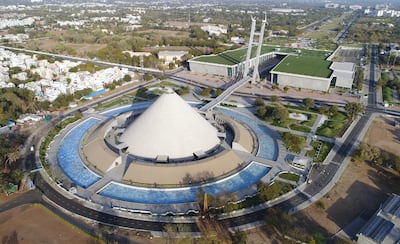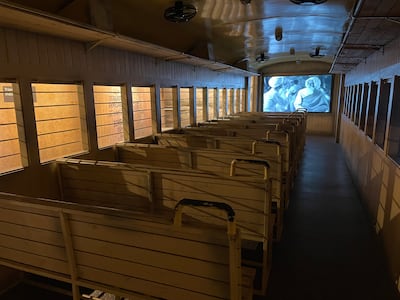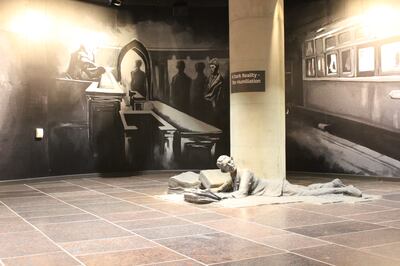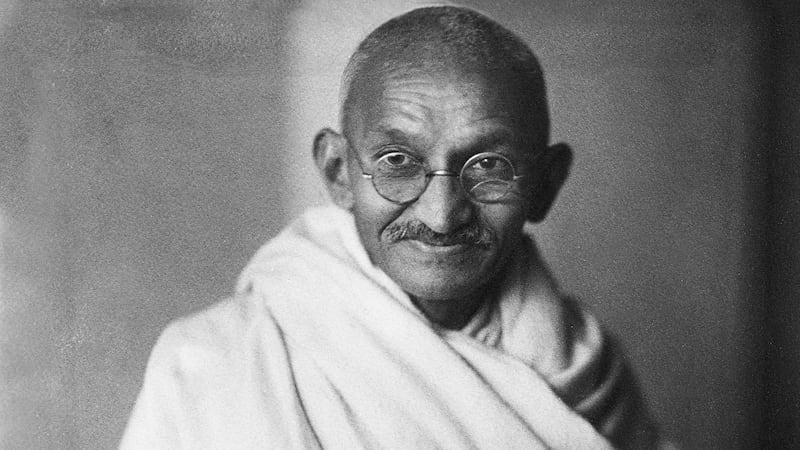Monday marks Gandhi Jayanti, an annual Indian national holiday celebrating Mahatma Gandhi's birthday. To mark the occasion, The National visited Dandi Kutir, a museum in Gujarat devoted to the lawyer and pioneering non-violent activist who helped lead the way to India's independence from British rule.
Located in the planned urban district of the capital of Gujarat, Gandhinagar, the museum is part of the environmentally friendly convention centre Mahatma Mandir and was inaugurated in 2015. Designed by Shapoorji Pallonji Engineering and Construction and architects from Cept, Ahmedabad, the building takes the shape of a sand mound – inspired by the Dandi March of 1930, when Gandhi led a protest against the salt tax imposed by the British.
Interestingly, the sea salt produced at the Rann of Kutch in Gujarat is processed by evaporating seawater from the salt pans and the collected salt is placed in mounds over the dry sand. As one enters the museum, its sprawling design is immediately gripping; the hollow concrete shell rises 41 meters tall, with a diameter of 90 metres.

With an industrial, cement-hued concrete finish, the top has a large circular skylight that ensures ample natural light enters the building during the day. There are three levels other than the ground floor, and glass and steel ramps provide access to each, as well as stairs and elevators.
The museum is the centrepiece of the expansive 60,000-square-metre Mahatma Mandir convention and exhibition centre and memorial complex. On the outside, a wide canal of water surrounds the structure, representing the sea and a suspended bridge from the convention centre to the cone is symbolic of a ceremonial entry. The whole space is set amid beautifully landscaped gardens, and surrounded by an exterior circular plaza for pedestrian access.
Spread over a whopping 10,700 square metres, the museum bets big on technology with temporary exhibits spanning 1,900 square metres.
The museum uses about 14 different kinds of multimedia technologies to immerse guests in the life of Gandhi, with 82 minutes of multimedia experiences. The space uses 3D mapping, transparent LED screens, 360-degree projections and holography to provide a dramatic biographical narrative of his life and its milestones.

Live Pixel Technologies has developed a VFX model of Gandhi, utilising the same space and face replacement technologies used in films like Avatar. Renowned scriptwriter Atul Tiwari has also written the script for the voice-overs.
The third floor showcases Gandhi’s childhood and his early days as Mohandas. This is where visitors can see glimpses of his early life from his birth on October 2 1869, his childhood as a shy yet remarkable student, his marriage to Kasturba (who is the subject of her own special hall) and his experiments with youth.
The social context of the early days is shown through 3D mapping projection, which is used as a storytelling tool to create an interesting narrative of his early life. The second floor showcases his leadership during the times of his agitation in South Africa and how he held the “Great March” of Indian residents from Natal to Transvaal.

The 360-degree theatre and interactive media exhibits on the same floor add another element of interactivity. There is also a sculpture of Gandhi lying on the ground with his belongings scattered around him after being thrown out of a train in South Africa.
The first floor is dedicated to Gandhi’s travels in India and the Independence movement. The must-see here is the holographic impression of Sabarmati Ashram that spread the message of self-reliance (Swadeshi). This is where visitors can learn about how he pushed for a new economic and social order and the need to be self-sufficient and non-exploitative. The ground floor has a stunning visual of the Satyagraha movement spreading across the world.
One of the most important objects associated with Gandhi is the spinning wheel or chakra. As an ode to this, there is a 15-metre high chakra, covered by fibreglass-reinforced polymer, placed on the roof of the convention centre.

The museum is designed to be a biography that uses an interplay of audiovisual mediums to keep the visitors engaged. There is one wall that lists the names of people who joined the Mahatma in the Dandi March. Also of note is rare video footage of the Boer War, Partition and Independence showcased here.
As visitors navigate the spaces, they cannot help but feel they are walking in the shoes of the Mahatma. The museum is sure to offer a personal perspective of how he helped India gain its Independence.
Finally, stepping out of the museum, one cannot help but notice Gandhi’s famous words etched on a wall and think how true his words ring even in today’s times: “Be the change you wish to see in the world".






